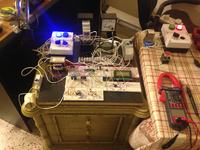KhaledOsmani
Full Member level 6
Sorry I made the same mistake as you did! Put 10R to the 5V supply and 10K to the ground (in parallel to the capacitor).
Hello c_mitra,
I changed the circuit with resistors/cap values to yours.
Result: Same.
When unplugging the load, either by removing it from socked, or by switching off its MCB, the system behaves as if the user had pressed the push-button.
Thank you
P.s the push-button is rated at 10A, and looks like this one:
https://ar.aliexpress.com/item/Chea...2283684425.html?spm=2114.51010308.4.18.uf0M4j
- - - Updated - - -
Hello,
I've changed the decoupling capacitors value at both VDD & VSS pins from 10nF parallel with two 1uF at each side, to 10nF parallel with 10uF at both sides.
The first time I tried to unplug the load, no re-direction to 'capbankcalc' loop was there (system did not receive it as pressing the pushbutton).
At later tries, with same 10nF parallel with 10uF at both sides, when unplugging the load, the system returned to old behavior as seeing this as pressing the push-button.
Thanks



